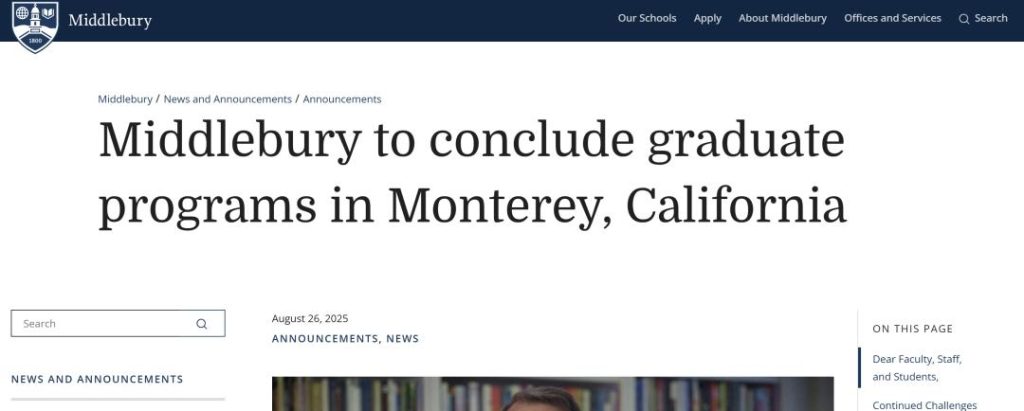
Read More《AI冲击下的第一所牺牲名校:蒙特雷国际研究院走向终点》
Positive Comments: The Closure of MIIS as a “Wake-up Call” and “Catalyst” for the Transformation of Language Education in the AI Era
The demise of the Monterey Institute of International Studies (MIIS), though regrettable, has sounded a crucial alarm for the global language education industry. Through the “sacrifice” of a top – tier institution, it has revealed the urgency of proactively innovating the education model in the wave of AI technology and provided a reference direction for the industry’s transformation.
Firstly, the closure of MIIS has directly exposed the core contradiction between traditional language education and industrial needs, prompting educational institutions to re – examine the fundamental question of “what kind of talents to cultivate”. MIIS’s glory stemmed from its precise cultivation of high – end translation talents such as “high – priced simultaneous interpreters” and “professional translators”. This model was irreplaceable in the era when machine translation was not yet mature. However, with the popularization of generative AI and machine translation tools, the efficiency and cost of basic translation tasks have been significantly restructured. Enterprises no longer need a large number of talents who can “independently complete translations” but rather compound talents who can manage AI tools, optimize translation processes, handle terminology governance, and deal with content digitization. MIIS’s curriculum system failed to adjust in a timely manner and still centered on “pure translation training”, resulting in a mismatch between students’ employment prospects and market demands, and ultimately losing its attractiveness for enrollment. This case warns educational institutions that in an era of rapid technological iteration, the “halo of a famous school” and “historical reputation” cannot replace a keen insight into industrial trends, and the curriculum content must be dynamically matched with industry job requirements.
Secondly, the demise of MIIS has accelerated the transformation of language education from “skill – oriented” to “ability – integrated”, creating space for the exploration of new educational models. AI has not eliminated the demand for languages but has reconstructed the application scenarios of language abilities, shifting from “independently outputting translation results” to “process management and optimization under human – machine collaboration”. This means that future language education needs to deeply integrate language abilities with data thinking, tool usage, cross – cultural collaboration, and other abilities. The closure of MIIS has provided the industry with a “trial – and – error sample”. When the traditional model fails, educational institutions must actively embrace change, such as developing new courses like “localization project management” and “AI translation quality control”, introducing real – world enterprise cases as teaching materials, and even collaborating with technology companies to develop AI – assisted teaching tools. This transformation can not only enhance students’ employability but also enable language education to find a new value anchor in the AI era.
Finally, the MIIS incident has promoted a rational reflection on the “cost – benefit” model in the education industry, providing a reference for a more sustainable education model. MIIS’s financial crisis is not an isolated incident. High tuition fees, high operating costs (such as the cost of living in Monterey), and a low enrollment scale have formed a vicious circle. Online education and career – oriented programs (such as short – term skills training and enterprise – customized courses) have shown stronger resilience in the AI era due to their lower costs and greater flexibility. This prompts educational institutions (especially private colleges) to re – evaluate their operating models: Are they overly reliant on offline immersive experiences? Can they reduce costs through online – offline integration (OMO)? Should they focus on niche areas (such as vertical training in legal translation and medical translation) to enhance their differential competitiveness? The “sacrifice” of MIIS is essentially the failure of the old education economic model, and this failure has provided the impetus for the industry to explore a more efficient and market – oriented new model.
Negative Comments: The Pains and Hidden Worries Behind the Demise of a Famous School – The Loss of Traditional Education Values and Transformation Risks
Although the closure of MIIS is inevitable, it also reflects the deep – seated contradictions and potential risks in education transformation in the AI era. As a global benchmark for language education, its demise is not only the end of a school but may also trigger a series of chain reactions, which deserve the industry’s vigilance.
Firstly, the loss of high – quality educational resources may weaken the “humanistic depth” of language education. MIIS’s core value lies not only in cultivating “translation craftsmen” but also in its inheritance of cross – cultural understanding and in – depth language abilities (such as literary translation and precise expression in diplomatic negotiations). These abilities are difficult to be completely replaced by AI. Machine translation can handle 80% of standardized texts, but the artistic conception of poetry, the subtle nuances of diplomatic language, and the translation of cultural metaphors still require the “empathy” and “insight” of human translators. The closure of MIIS may lead to the shrinkage of such “non – standardized” language education resources, and the market – driven education model tends to cultivate “tool – type” talents, which may cause language education to gradually lose its humanistic attributes and become a “technological appendage”.
Secondly, over – reliance on AI may ignore the essential logic of language learning, leading to a deviation from educational goals. The news mentioned that “the logic of learning English has not changed”, but in reality, when educational institutions over – emphasize “AI tool usage” to meet market demands, they may weaken the cultivation of basic language abilities (such as grammar, vocabulary, and logical expression). For example, if the focus of the curriculum shifts from “improving English writing ability” to “how to use ChatGPT to optimize the translation process”, students may neglect to consolidate their language foundation due to their reliance on tools, ultimately resulting in a vicious circle of “the stronger the tool, the weaker the ability”. The closure of MIIS is, to some extent, a negation of the “old model” by the market. However, if the industry moves to the other extreme and completely abandons the essence of traditional language training, it may damage the long – term value of language education.
Thirdly, the management problems behind the financial crisis have exposed the “passivity” of educational institutions in responding to transformation, which may exacerbate the “collateral damage” in the industry reshuffle. MIIS had a deficit of up to $8.7 million, and the school’s previous debt of $45 million failed to reverse the decline, which reflects its slow response in dealing with the impact of AI. For example, did it prematurely predict the survival period of traditional translation jobs? Did it fail to adjust its enrollment strategy in a timely manner (such as reducing tuition fees and increasing the proportion of international students)? Did it lack in – depth cooperation with enterprises to obtain industry feedback? The characteristic of educational institutions being “too big to turn around” may cause high – quality educational brands to be forced to withdraw due to short – term financial pressure, and such “collateral damage” may cause the industry to lose valuable experience accumulation and cultural inheritance.
Advice for Entrepreneurs: Anchoring the “New Coordinates” of Language Education in the AI Wave
The closure of MIIS has provided important insights for entrepreneurs, especially those in the education field. Considering the core contradictions of the event and industry trends, the following advice is worth referring to:
Replace “Experience Dependence” with “Demand Penetration” to Precisely Position the Value of Courses
Entrepreneurs need to break free from the path dependence of the “famous school model” and conduct in – depth research on the real industrial needs. For example, by collaborating with translation companies and multinational enterprises, they can sort out new language service jobs in the AI era (such as localization project managers and AI translation quality engineers), clarify the “language + data + tool” compound abilities required for these jobs, and then design the curriculum content. Avoid blindly replicating the “skill training” logic of traditional education, and instead develop case – based teaching and simulation practice modules around the “human – machine collaboration” scenario.Enhance Flexibility with a “Light – Asset Model” to Balance Costs and Benefits
Drawing on the successful experiences of online education and vocational training, entrepreneurs can explore the OMO model of “mainly online, supplemented by offline”: Core courses are delivered through online platforms to reduce venue costs, and offline sessions focus on value – added services such as practical workshops and enterprise visits. At the same time, develop vertical courses for niche areas (such as medical translation and legal translation) to avoid homogeneous competition with comprehensive universities and enhance pricing power through differentiation.Drive with Both “Humanities + Technology” to Protect the Core Value of Language Education
While emphasizing the application of AI tools, entrepreneurs need to preserve the humanistic core of language education. For example, set up modules such as “cross – cultural communication” and “literary translation appreciation” in the curriculum to cultivate students’ ability to understand the deep meaning of language; add content such as “ethical boundaries” and “quality control” in the teaching of AI tool usage to prevent students from becoming mere “tool operators”. Only by combining technological capabilities with humanistic qualities can we cultivate irreplaceable “compound language talents”.Build Risk – Resistance Ability through “Ecological Cooperation” to Avoid “Working in Isolation”
Entrepreneurs should actively establish a cooperation ecosystem with technology companies (such as AI translation tool manufacturers) and enterprise users (such as multinational companies in need of localization services). Collaborate with technology companies to develop AI – assisted teaching tools, build “internship – employment” channels with enterprises, and even undertake enterprise – customized training projects. Through ecological cooperation, they can not only obtain cutting – edge industrial needs but also reduce customer acquisition costs through enterprise resources and enhance the sustainability of the project.
The demise of MIIS is a footnote rather than an end to education transformation in the AI era. It reminds us that the technological wave will outdated models but will not eliminate the demand itself. For entrepreneurs, the key lies in finding a new balance between “technological change” and “humanistic inheritance” with a more keen insight and more flexible model innovation, so that language education can maintain a more lasting vitality in the AI era.
- Startup Commentary”Building LLMs: The Knowledge Graph Foundation Every AI Project Needs”
- Startup Commentary”The 17th Year of Tmall Double 11 and the New Map Rewritten by AI”
- Startup Commentary”How to Prepare Your Data for Artificial Intelligence”
- Startup Commentary”Small and Medium-sized Banks: “Cutting the Tail” in Loan Assistance”
- Startup Commentary”The Six AI Giants on Stage: AGI Is No Longer a “Future” Thing”




